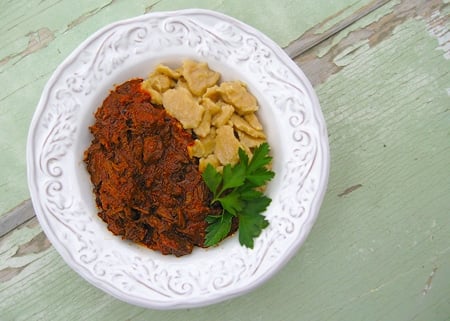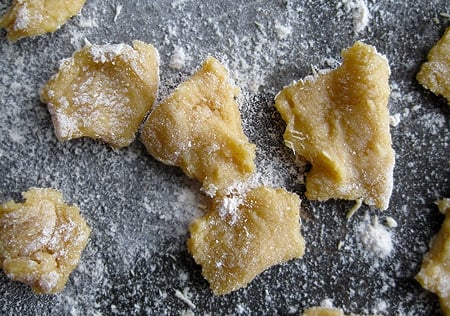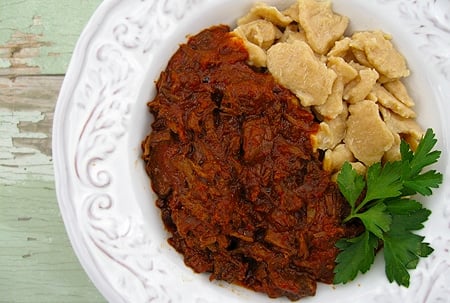As an Amazon Associate I earn from qualifying purchases.

Goulash. Love the name. Sounds so mysterious, like something warriors in the Dark Ages would have wolfed down to make them strong before battle. I grew up eating my mum’s goulash, and it was good. But, sadly, it wasn’t actually goulash. It was chili. I only learned this years later, after I ordered goulash at a Hungarian restaurant in Wisconsin. What they served me looked nothing like chili, and everything like what you see above: A thick, meaty stew heavy on the paprika, served with little pasta dumplings on the side.
Making an authentic goulash is like running a gauntlet. There really is no one “authentic” goulash, as every Hungarian cook makes it her own way. Tomatoes? Green peppers? Verboten in some recipes, required in others. Sour cream? Typically only allowed as a tableside condiment, if at all — there is another dish, paprikash, that includes sour cream mixed into the stew itself. Vegetables? Sometimes, and most often carrots, parsnips and potatoes. Wine? Not usually. Stock. A little, if any. Beans? Hell, no!
After no small amount of research, the only constants I can determine are paprika and onions. Lots of onions and lots of paprika. More than you think you’d need.
As for the meat, beef is the most common I’ve seen, but as this is a wild food website, my goulash uses venison. Feel free to use any red meat here, from beef to bison to any form of venison; I used some pronghorn antelope given to me by a friend. If you are a vegetarian, I’ve seen mushroom goulash in Hungarian cookbooks, so use them instead.
What to serve your goulash with is also variable. Mashed, boiled or smashed potatoes are all common, as is spaetzle. This, I think, is an Austrian touch: Those of you who remember your history might recall that there was once this thing called the Austro-Hungarian Empire. Anyone care to guess who Franz Ferdinand and Gavrilo Princip were?
Since I wanted to make a Hungarian goulash, not the Austrian version (which also has sauerkraut in it) I went with the Hungarian version of spaetzle: a little pasta dumpling called csipetke (chip-ET-keh). Basically its an egg pasta dough pinched off into rough little noodley dumplings, which are either boiled in water or in the soup they go with. But because I made what the Hungarians called a porkolt — a really thick stew — you couldn’t boil the dumplings in it, so I cooked them in salty water and served them alongside.

The key to my version of Hungarian goulash is time. Cooking venison requires patience… and a potato masher. You cook the stew slowly for hours and then, when the meat is thinking about falling apart, mash the whole shebang with a potato masher to combine. This integrates everything and prevents that dryness you can get in the center of stewed venison chunks.
As for the csipetke, if there is an easier pasta to make I’m not aware of it. You need no tools other than your hands.
This is a perfect hunting camp meal or easy Sunday dinner. All it asks of you is time, and it rewards you with a spicy, rich, meaty bowl of goodness that sticks to your ribs and makes you want to come back for seconds. Jó étvágyat!

[recipe_name]hungarian venison goulash[/recipe_name]
[summary]This is a reasonably authentic Hungarian goulash recipe, albeit stripped down to its basics and made with venison. But hey, they hunt in Hungary, right? You will want fresh paprika for this recipe, meaning the stuff that has likely been sitting around in your pantry since the Jurassic Period won’t cut it. Paprika needs to be bright red and smell wonderful. And if you don’t want angry Hungarians beating down your door, buy Hungarian Paprika.
I used antelope stew meat here, but any stew meat will work: Deer, moose, caribou, bison, and yes, beef and lamb work fine. I suppose you could make this with muskrats or hares and jackrabbits, too, if you stew them a long time and then pull off all the meat.
Oh, and don’t freak out about the huge amount of onions. They cook down.
Make the csipetke dumplings as the stew cooks; they only take an hour or so. Or just serve the goulash with mashed potatoes, pasta or even rice.[/summary]
[yield]Serves 4-6. [/yield]
Prep Time: [preptime time=20M] 20 minutes [/preptime]
Cook Time: [cooktime time=4H] 4 hours [/cooktime]
CSIPETKE
- 1 cup flour
- 1 teaspoon salt
- 2 eggs, beaten
GOULASH
- 1/4 cup lard or sunflower oil
- 2 pounds venison stew meat, cut into chunks
- Salt
- 4-5 cups chopped onions
- 1/3 cup sweet paprika
- 1 tablespoon hot paprika
- 2 teaspoons caraway seed, divided
- 2 cups venison or beef stock
- 2 cups water
________
[instructions]
- To make the csipetke dumplings, mix the dough together and knead until it’s smooth, about 5 minutes. If the dough is really sticky, add more flour. You want a stiff, but pliable dough. Cover in plastic wrap and set aside for 1 hour at room temperature. To make the dumplings, pinch off dime-sized little bits of the dough and flip them onto a well-floured surface. This can be done up to several hours ahead.
- Heat the lard over medium-high heat in a large Dutch oven or stewpot and brown the venison in batches. Salt the venison as it cooks. It will take 20 minutes or so for all the meat to brown. Remove the venison as it browns and set aside.
- Add all the onions and turn the heat to high. Saute the onions, stirring often, until they are browned. Add the venison back, then all the other ingredients except for 1 teaspoon of caraway seed. Mix well and bring to a simmer. Cover and cook over low heat for 3-5 hours, or until the meat wants to fall apart.
- To finish the dish, boil the csipetke dumplings for a few minutes in salty water, then drain and set aside. Use a potato masher to squash all the meat in the pot, then add the last teaspoon of caraway seed and mix well. Add salt if needed. Serve the goulash alongside the dumplings with some sour cream at the table to mix in.
[/instructions]





Hank:
Happy to be of service. You probably don’t remember me but we met at a dinner in Arlington, VA when you were doing your Hunter, Gatherer book tour. I have a freezer full of elk and plan to make a batch of goulash out of some of the roasts. Emily sent you a pic from a recent snow goose hunt on the Eastern Shore. If you ever get back this way during the season, let me know. I do a lot of hunting for Canada and snow geese. We could work you in for a hunt.
Look forward to hearing from you.
Regards,
Mark
Hello Hank:
First time comment but long time follower. I’d like to challenge you on the battle order here. The caraway. Why do you put it in last? The flavor of the caraway is most in an oil, which is not water soluble. When I make goulash, I toast the caraway seeds in a hot skillet and after they have cooled, I grind them in a spice grinder. Then, after the onions have gotten to the color I want them, I add the toasted, ground caraway seed. The oil in the caraway seed will then flavor the fat I’m browning the onions in. It seems to me a better way to extract the flavor from the caraway seed. The way you do it, you leave it to the water based stock to extract the flavor, which will be incomplete at best.
Regards,
Mark
Mark: I actually agree. And as it happens, I *just* revised this recipe last night. Serendipity. Will post the new version in a week or so.
Hi the chipetke does not come with the gulyas (goulash). The csipetke goes into soups and does not contains any eggs.
This called nokedli or dumplings what requires 1 tablespoon oil as well. And you do not wait as soon as you made the dough start to cook it otherwise it will be too chewy. The dough has to be very soft really sticky.
For the venison porkolt (goulash) it is very important the red vine. You cook it with red vine what makes the meat very soft and brings out the taste of the venison but will not become too meaty.
First you satee the onions then the meat and add the paprika then the vine and small amount of water. You cook it on the slow gas. Even if it takes ages you cook it as slow as you can.
I just cut up a “ham” which produced about 4.5 lbs. of cubes. Should I simply double all the remaining ingredients? How long will it take to cook? I’m making it now—only ingredients missing is the hot paprika so I’ll use all sweet.
Thanks! Love the site!
Hank, congratulation to your website and your extended research on Hungarian recipes.
I am a full booded, first generation Hungarian. You are right about the different gulyas ingredients, in different kitchens. I love that… beans Hell No!
I want to clarify one thing. The Name of your dish in the picture above is not Gulyas it is Porkolt. (With umlauts) or paprikas.
The Gulyas is a stew (heavy soup) with potatoes, carrots, parsnip etc.
the recipes are great, and as other people mentioned each family add their own seasonings and passed down to generations.
Happy cooking to all!
I make chicken paprikash pretty frequently but I see goulash and dumplings in my near future. This stuff looks kick-ass
I have aLOT of venison stew meat and aLot of paprika my husband bought from Hungary…This recipe is definitely in my future!
Yeah, that’s about the right recipe. It’s in the nature of goulash for the recipe to vary from person to person and village to village, so one should not feel bad about not hewing exactly to one recipe or another.
I’m personally a bit more fond of paprikash myself, particularly chicken. I, my dad before me, and his mother (who came over from Austria-Hungary) make and made this with the larger dumplings – half a teaspoon to a whole teaspoon of the same dough you describe. Both sides of my family come from the borderlands of Austria and Hungary and from a farmer’s tradition of scrimping and saving, so we make the dough with only one egg and some water. The same dough makes excellent drop-from-the-spoon noodles cooked directly in a soup (with a slightly wetter dough) or, with a slightly drier dough, grated across the second-largest-hole side of a box grater to make pea-sized noodles (“gehrschtel”) which are dried before adding to the soup for cooking. These soups are usually clear broth – usually chicken, sometimes beef – with meat, onion, celery, carrot and parsley the usual ingredients. My dad and I are fond of serving such with potato pancakes alongside.
When making chicken paprikash, I like to brown the chicken skin in its own fat, first, then sweat lots of onions in the same, then cook with celery and carrot and the dumplings in the paprika-sour cream-a little stock. The key is going low and slow with this, too, because too high a heat will break the sour cream and make the dish a bit less visually appealing, though no less tasty.
And all of this is ideal for dinner after a day of late-season hunting.
That’s very close to the version my dad used to make. He was German, but the family recipe comes from Austria.
He always put in mushrooms and a few cubed red potatoes as well. There was a little more broth than what is in your photo, and he left the meat more or less in cubes rather than mashing it, but other than that, your recipe looks like what I grew up with. And the flavor… MY GOD. Nothing like it after a day spent out in the cold.
People look at me funny when I tell them how much paprika I use. It almost becomes a thickening agent, but it makes all the difference. Matthew might not have been joking.
that’s so funny, I just blogged the same thing 🙂 bet yours was way better though ! Your csipetke definitely look better than the mess I made !
Hey, great recipe. We had it for dinner tonight, made with an antelope roast. I have never made pasta before, and that was quite fun and easy. Kids loved the homemade noodles.And my youngest daughter absolutely loved the goulash. I did add two finely chopped carrots to sweeten it up, and a splash of red wine to deepen the flavors a bit. It was a hit, and very different from the antelope pot roasts we usually eat. Thanks for the inspiration.
This looks lovely! As fates would have it, I was planning on a pork goulash next week and having looked through numerous recipes and seeing so many differences, I too was pondering what actually defined a goulash! I wish I had venison to hand. Sadly I don’t but this has all the same made me more determined to enjoy the goulash that I do make next week!
And I like the idea of, if your stew is thin enough, cooking the dumplings in it. I imagine that would be incredibly tasty.
Matthew: That’s a joke, right? 1/3 cup of sweet paprika + another tablespoon of hot? It’s actually more than I’ve seen in all but a few recipes written in Hungarian!
Noelle: I wonder if that version of “goulash” was an American 1970s staple? That’s when mom made hers, too.
Cork: Cool tips! I like the idea of frying the dried pasta in oil before boiling them.
Looks great, Hank! My buddy from Szeged taught me how to make proper Hungarian Peukolt (got no umlauts on my keyboard), or as it’s also called “Goulyash” (named after the Hungarian name for “cattleman” or “cowboy”). The big dumplings you’ve got are very much part of the old Austrian days. Tarhonya (https://www.amazon.com/Tarhonya-Drop-Noodles-Bende-8-8oz/dp/B000LRFZYI/ref=sr_1_sc_1?s=grocery&ie=UTF8&qid=1325706471&sr=1-1-spell) is what’s more often used in Hungary: the smaller the better. The dry tarhonaya’s first fried in olive oil to brown lightly, and give it a nutty flavor, then boileld to soften. I’ve tried peukolt with pork, as he had shown me, and then with bear, wish is to die for! …I was invited for paprikash couple weeks ago, which is exactly the same, except in Peukolt, you brown and in paprikash you just start boiling. He just got back from a semester teaching at the local medical school and brought me a bottle of pear pahlinka and large jars fresh Hungarian paprika (makes great BBQ sauce, too!) and that fresh Hungarian paprika, which has that sweet tang at the end, is what makes GREAT peukolt!
My dad just gave me a bunch of venison stew meat, a departure from the burger he usually gives us, and I was planning on visiting your site for recipes when this popped up in my reader, so thanks!
As a child of the ’70s, I can relate to your mom’s goulash- that was in my mom’s repertoire as well. I think back then it was just synonymous with “whatever you want to put in a pot”, as long as the finished product was red.
This is perfect timing, I was trying to decide what to do with some moose “stew meat” that keeps looking at me everytime I open the freezer, but have been passing it up for ground.
I guess it’s time to order some paprika.
Looks like a perfect winter dish. I will have to try this out.
sounds good! I’ve been using the venison paprika recipe from “Eat Like A Wild Man” for years. That book doesn’t refer to it as a goulash, but it seems to fit the bill, IMO. that recipe does include tomatoes, however.
That’s not enough paprika!
I remember being at my grandparents house in Wisconsin growing up and my grandpa served up his goulash. With everything he put in there, it looked so gross (to a 6 year old) but my parents made me be polite and eat it. I’m sure glad I did! He’s been gone a long time now, and what I wouldn’t give for a taste of Grandpa’s Goulash.